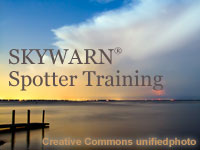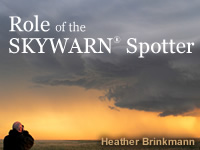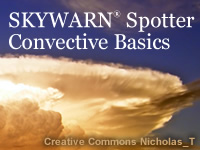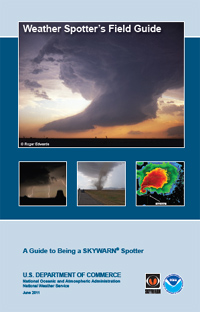
Across the Nation, dedicated volunteers risk their personal safety to provide first-hand reports of hazardous weather, including floods, hail, damaging or destructive winds, tornadoes, wildfires, winter storms, and more, to their local officials, and the National Weather Service (NWS). The same occurs across the Rio Grande Valley and Deep South Texas. A Skywarn® Storm Spotter’s primary reason to become certified is to help protect the lives and property of the citizens across the region. Being a storm spotter not only means dedication, but also training. Each spring NWS Brownsville/Rio Grande Valley trains members of the police, fire department, emergency management (including health, education, transportation, land management and more), the amateur radio community, and public citizens in the latest storm spotting techniques. Typically the training is coordinated by a local group such as an emergency management agency, public health agency, or local media entity. An NWS meteorologist serves as the guest instructor. The goal of the training is to prepare the spotter to identify hazardous weather conditions, how to report that information to the local NWS, and personal safety. This year, we’re taking a two–pronged approach to our training plan:
Self-Paced Online Skywarn Training Courses Note: These courses are NOT produced by the NWS office in Brownsville. |
|
|
Skywarn® Spotter Training Intro **START HERE!** You can choose to register as a Basic Skywarn® Spotter with NWS Brownsville/Rio Grande Valley by using the checkbox that appears after you Enroll in this course. When you check the box, you will be registered with us after passing the course(s). |
 |
|
Role of the Skywarn® Spotter |
 |
|
Skywarn® Spotter Convective Basics |
 |
|
Each course is free, but requires a simple and quick registration to access. This can be done from the links provided above and below. The Meteorological Education (MetEd) website provides education and training resources to benefit the operational forecaster community, university atmospheric scientists and students, and anyone interested in learning more about meteorology, weather forecasting, and related geoscience topics. MetEd is populated and maintained by the COMET® Program, which is part of the University Corporation for Atmospheric Research's (UCAR's) Community Programs (UCP). The MetEd website is made possible by the sponsors of the COMET® Program. MetEd has a variety of interesting courses for scientists and non–scientists alike; feel free to browse the site for other courses. Once you complete these two courses, email your certificate to Barry.Goldsmith@noaa.gov and you will be added to our spotter database. We will contact you to ask for information that will be added to our database. Within a few weeks, you will receive a certificate, welcoming letter and ID card via e-mail. If you’re a Winter Texan, your County Identifier will match your temporary residence in the Rio Grande Valley. The ID will be in the form CCC–NNNB, where CCC = your County Identifier and NNN = your identification number. The trailing "B" after your ID number indicates you completed just the MetEd coursework and certified as Basic. If you’re interested in becoming a fully trained spotter in the Rio Grande Valley, you’ll need to follow the online courses with a visit to one of our local virtual courses. Read on for details. Virtual Classes NWS Brownsville/Rio Grande Valley will continue to provide virtual classes in order to reach more people who may not be able to attend in person, especially during normal business hours. These classes will be provided via webinar. These local classes complement the MetEd online courses by giving students the unique Rio Grande Valley "flavor". Since the online courses cover the basics of spotting and thunderstorm development, local classes focus on features in the sky and on the ground, with a short introduction on NWS Brownsville/Rio Grande Valley, how to report hazardous weather, and severe weather climatology. These local virtual classes will be just an hour long, including interactive elements. An online course evaluation form will also be provided. Local classes in 2021 will be scheduled between late January and April. Students who complete all prescribed courses will receive a certificate, welcoming letter, and ID card as specified above, only the ID will end as number NNN. Requirements to participate in the webinar include:
Check back here for scheduled Webinars in 2025. |
|
|
Download our Weather Spotters Field Guide. (72 pages/ 27 MB) For more information contact: |
 |